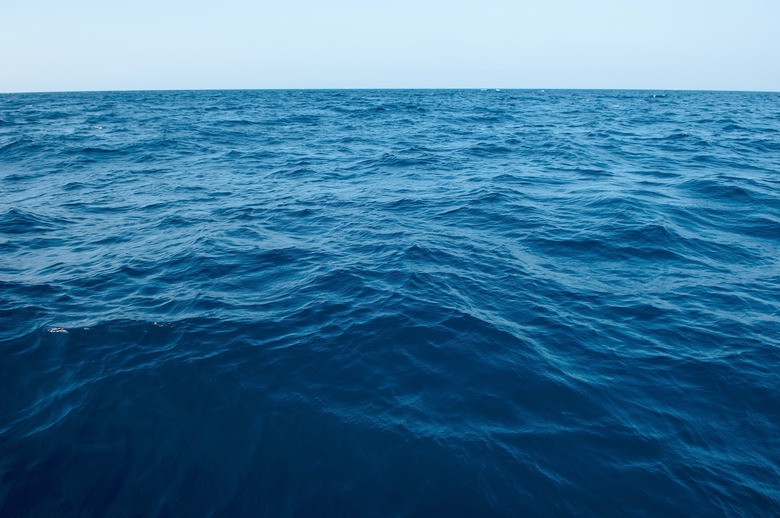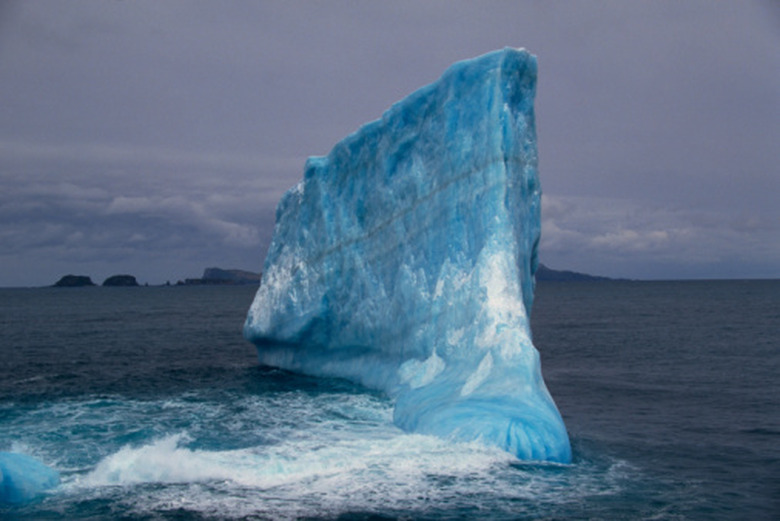What Are Deep Water Currents?
The ocean currents known since antiquity are called surface currents. Though these are invaluable to shipping, they are superficial and occupy only a small fraction of the ocean's waters. The majority of the ocean's currents take the form of a temperature- and salinity-driven "conveyor belt" that slowly churns water within the abyssal depths. These loops of water circulation are called deep currents.
Density-Driven Currents
Density-Driven Currents
Unlike the wind-driven surface currents, deep water currents are driven by differences in water density: heavier water sinks while lighter water rises. The main determinants of water density are temperature and salt concentration; thus, the deep currents are thermohaline (temperature- and salt-driven) currents. Water at the polar latitudes sinks because it is cold and displaces the water beneath it, pushing it along the contours of the ocean basin. Eventually, this water pushes back up to the surface in a process called upwelling.
Changes in Salinity
Changes in Salinity
The waters of the ocean are not a homogeneous mixture. For instance, the water of the Atlantic Ocean is somewhat lower but more saline than that of the Pacific Ocean due to the differential distribution of deep current waters. Even within a given area of ocean, the water is not evenly mixed; denser, more saline waters lay below fresher surface water.
Salinity changes when water but not salt is added or removed from surface water. This generally happens either by evaporation due to the wind, precipitation due to rainfall or the formation and melting of icebergs in polar regions. It is ultimately the combination of temperature and salinity that determines whether a mass of water will sink or rise. The thermohaline streams of the world's oceans are named after the origin and destination of the current.
Deep Currents are Slow
Deep Currents are Slow
Surface currents may reach several kilometers per hour and have a noticeable effect on oceanic travel. Deep currents are much slower and may take many years to traverse the world's oceans. This movement can be gauged by the composition of chemicals dissolved in the seawater. Chemical estimates largely agree with deep current measurements and indicate that currents take up to a thousand years to reach the surface, as seems to be the case with the North Pacific current.
Effects on Global Climate
Effects on Global Climate
The movement of temperature and energy by the deep ocean currents is massive and undoubtedly has a significant effect on global climate. The precise nature of these climatic effects is still somewhat uncertain. It seems that warmer surface currents result in the relative warming of a large region, while cold water upwelling results in that region being cooler than expected. For instance, the North Atlantic current supplies warm water to western Europe, resulting in a warmer than expected temperature. The relative cooling during the "Little Ice Age" of 1400-1850 was presumably the result of a slowing and subsequent cooling of this surface current.
Deep currents have additional implications on the global climate. For instance, cold ocean water contains substantial carbon dioxide, acting as a CO2 sink for vast amounts of atmospheric carbon. A relative warming of these cold currents, then, could result in a substantial release of stored CO2 into the atmospehre.
Cite This Article
MLA
Robison, Christopher. "What Are Deep Water Currents?" sciencing.com, https://www.sciencing.com/deep-water-currents-8060934/. 22 November 2019.
APA
Robison, Christopher. (2019, November 22). What Are Deep Water Currents?. sciencing.com. Retrieved from https://www.sciencing.com/deep-water-currents-8060934/
Chicago
Robison, Christopher. What Are Deep Water Currents? last modified March 24, 2022. https://www.sciencing.com/deep-water-currents-8060934/


